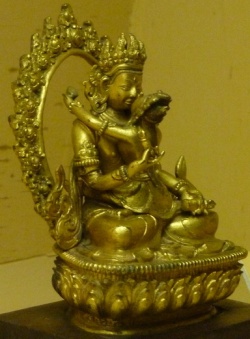Yoga tantra
The Yoga tantra, or tantra of union with the nature, is thus called because it emphasizes inner practice more than outer conduct. The abhiseka given here is the same as that of Upa but with the addition of the blessing of the vajra master.
View: In regard to absolute truth the practitioner realizes the non-conceptual, ultimate nature and its expression – luminosity. As result of this realization, within the context of perfect relative truth, phenomena appear as the “mandala of adamantine space” (vajradhatu mandala).
Meditation: During formal meditation the practitioner visualizes himself as a deity and invites from the buddhafield a wisdom deity similar in form to himself, who usually remains in the space before the practitioner. The relationship between the deity and the practitioner is one of equals or friends. During objectless meditation, the practitioner merges his perception of phenomena with the absolute nature beyond characteristics and rests in evenness. Phenomena are thus seen as the play of wisdom manifesting as deities.
Action: The practitioner still strives for accomplishment through achieving the “good” and eschewing the “bad.” Chief importance is given to the yoga of the deity and the practitioner strives to benefit others.
Fruit: Realization is attained in three lifetimes.
